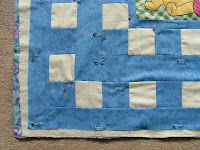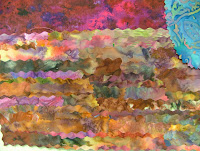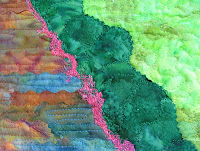A new baby arrived in the family in August, another great nephew for us, so my attention has been focused on making a quick play mat as a gift. It took me an evening to put together, with a pre-printed picture in the centre surrounded by 3 ½” squares and strips. Now it needs quilting by machine (it’s not worth doing hand work on an item that you hope will be used well and laundered often) so here’s how I put the layers together in preparation.
I cut the backing fabric 2” larger than the quilt top and lay it, RS down, onto the carpet.
I use safety pins to anchor it to the carpet, to hold it firm without stretching it.
Pinned edge
The batting, and the quilt top marked ready for quilting, is placed on top to make the three layers.
Three layers
I start by safety pinning the 3 layers together around the outside edge, before pinning the centre at 5” intervals.
Quilting lines
The quilting lines are marked through the middle of the squares so that they appear fragmented. The first quilting lines are sewn on either side of the border surrounding the panel to stabilise it. A walking foot (even-feed foot) is essential as it grips and feeds the layers through together. The stretch stitch I have chosen adds a bit of decorative detail.
Lines of straight stitches are then sewn from the edges of the inner border to the outer edges to secure the layers together and then I sewed round the lines parallel to the centre panel, working towards the outer edge. Easy quilting by any standards. Small motifs were added onto the quilt top for interest and the binding added. I didn’t have enough of the pale blue for the binding so chose the WS of a navy floral fabric.
Fused motifs
All I need to do now is quilt the printed panel, which is held stable and flat by the decorative stitches. I need to hand sew the binding and add the baby’s name and date of birth. Seeeemples! It will be posted this week and, I hope, gratefully received.
Binding





































